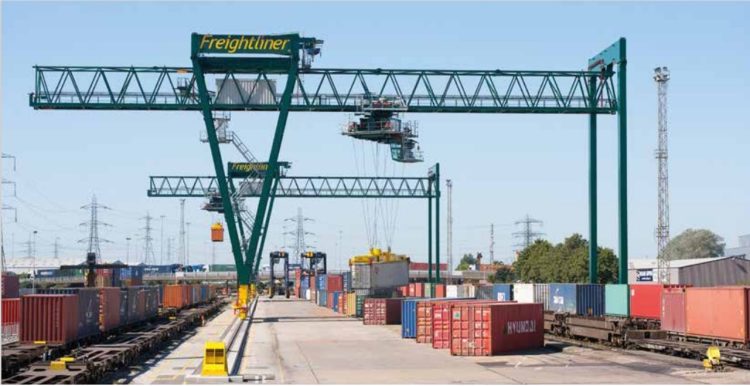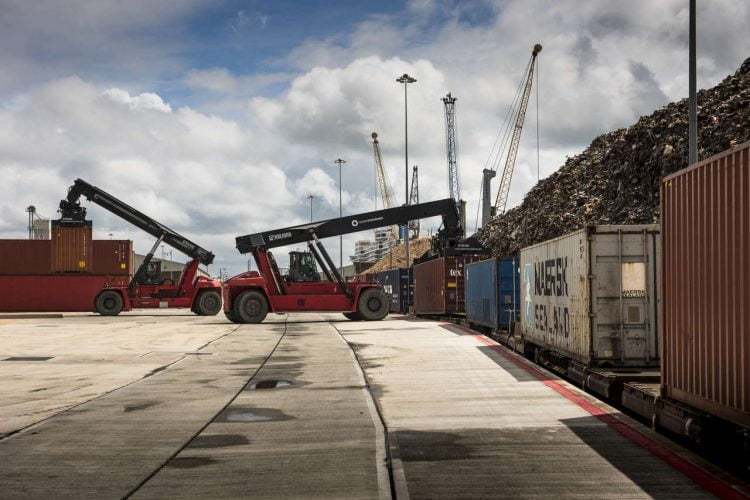Government announces target to increase rail freight by at least 75%
Transport Secretary, Mark Harper has announced an ambitious target to increase the amount freight transported by rail across the UK by rail by at least 75%.
The announcement made today, Thursday,, 20 December, is in line with the Government's drive to grow the rail freight industry, and boost the economic growth it brings with it by supporting supply chains and thousands of highly skilled jobs[1].
 Rail freight – the future of Britain's economy. // Credit: Rail Partners
Rail freight – the future of Britain's economy. // Credit: Rail Partners
The target provides the sector with certainty as it not only sets a clear pace for growth by 2050, but by taking lorries off the roads it will also lead to significant environmental benefits through slashing emissions and congestion. As an example, a single train can replace up to 129 HGVs, whilst a tonne of freight moved by train produces about 75% less carbon emissions than by road.
This announcement fulfils commitments made earlier this year by the Transport Secretary made a in his George Bradshaw address and the Department for Transport's Plan for Rail and Transport Decarbonisation.
 Intermodal train being loaded at the docks. // Credit: GB Railfreight[2]
Intermodal train being loaded at the docks. // Credit: GB Railfreight[2]
Following a detailed consultation with industry leaders, customers, and other stakeholders by the Great British Railways[3]' Transition Team (GBRTT), the transformative Ely[4] Area Capacity Enhancement scheme that was recently announced through the Network North plan will be supported by around £550 million of Government funding. Six extra freight trains per day to and from the Port of Felixstowe[5] will remove the equivalent of 98,000 lorry journeys off the road each year.
 GB Railfreight service from Stanton Gate. // Credit: GB Railfreight
GB Railfreight service from Stanton Gate. // Credit: GB Railfreight
Transport Secretary Mark Harper said: “Rail freight helps keeps this country moving, ensuring our supermarket shelves are stocked and materials are supplied to our construction workers.
“Not only is it the most efficient and environmentally friendly way of transporting many goods, but it helps grow the economy across the country.
“This ambitious plan demonstrates this Government's confidence in the rail freight sector, and I hope it encourages businesses to capitalise on the extra opportunities, so the industry continues to thrive and deliver for our country.”
GBRTT's Lead Director (interim) Rufus Boyd said: “The Government's announcement today, for a rail freight growth target of at least 75% growth by 2050, supports what our customers and stakeholders told us in the national Call for Evidence. That setting a clear ambition for rail freight growth will help bring the sector together, focus minds, break down silos, and be a catalyst for private investment.
“Rail freight is already a big success story. Moving goods by rail is a greener option and helps cut road congestion, and what we have here is an opportunity to grow rail freight's modal share. I am convinced that through collaborative working the industry can rise to this challenge.”
Director General of the Rail Freight Group Maggie Simpson said: “We are delighted that Government has recognised the economic and environmental benefits of growing rail freight. This target sends a strong message about the benefits and potential of rail freight which will encourage investment by industry and private businesses and attract more customers to move their goods by rail.”
Network Rail[6] freight director Henry Bates said: “Rail freight has a key role to play in Britain's economic and environmental wellbeing, keeping supermarkets stocked, builders building and medicine moving. We want to see more freight on rail and having a Government supported, long-term target will support the sector's ambition to grow and attract investment.”
Commenting on the announcement of a rail freight growth target of 75% by 2050, Rail Partners chief executive, Andy Bagnall said: ‘Today's announcement of a growth target for rail freight is a major step forward – the target will focus minds on the need to move goods in a more environmentally friendly way and give the sector more clarity to encourage investment.
‘While the 75% level of the growth target is a good start, we will need to go further to really shift the dial of moving freight from road to rail – if rail freight simply maintained its market share, that would mean 60% growth by 2050. So, the sector will now continue to work with government to put in place the policies needed to achieve, and exceed, the target – essential if the UK is to decarbonise logistics supply chains and meet its net zero goals.'
References
- ^ Posts tagged with Jobs (www.railadvent.co.uk)
- ^ Posts tagged with GB Railfreight (www.railadvent.co.uk)
- ^ Posts tagged with Great British Railways (www.railadvent.co.uk)
- ^ Posts tagged with Ely (www.railadvent.co.uk)
- ^ Posts tagged with Felixstowe (www.railadvent.co.uk)
- ^ Posts tagged with Network Rail (www.railadvent.co.uk)